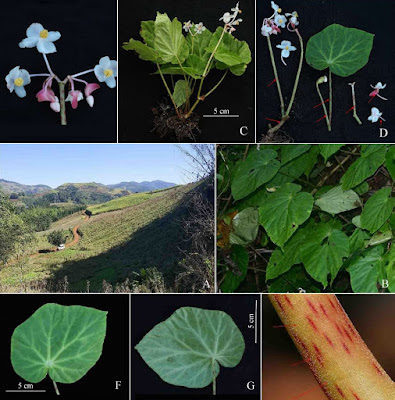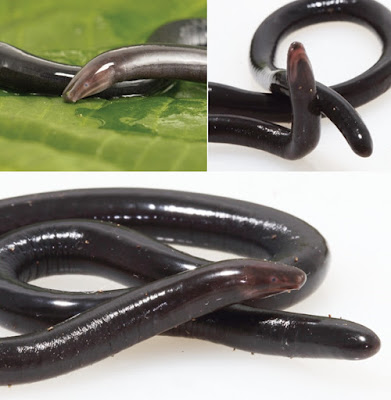[Most Recent Entries] [Calendar View]
Wednesday, November 6th, 2019
| Time | Event | ||
| 7:54a | [Botany • 2019] Begonia austroyunnanensis (Begoniaceae) • A New Species of Begonia from Yunnan, China
Abstract Begonia austroyunnanensis, a new species from Yunnan (China) is described and illustrated. This new species is similar to B. subhowii in having short erect stems, obliquely ovate leaves and white flowers, but can be distinguished by its stem, petioles and peduncle having conspicuous, red, linear dots and the much longer abaxial wing of the capsule. A detailed description, data on distribution, ecology and an illustration are provided. Keyword: Begonia, Begoniaceae, New taxon, Taxonomy, Western China, Yunan Begonia austroyunnanensis W.G.Wang, H.C.Xi & J.Y.Shen, sp. nov. 滇南秋海棠 The new species is similar to B. subhowii S. H. Huang in having short erect stems, obliquely ovate leaves, and white flowers, but can be distinguished by its its stem, petioles, and peduncle having conspicuous, red, linear dots and the much longer abaxial wing of the capsule. Etymology: The specific epithet “austroyunnanensis” refers to the type locality in southern Yunnan. Chinese name is proposed here as“滇南秋海棠” (滇南- refer to the southern Yunnan province, 秋海棠- refer to Begonia). Wen-Guang Wang, Hou-Cheng Xi, Xing-Da Ma, Li-Ju Jiang, Xiao-Jing Wang, Ji-Pu Shi and Jian-Yong Shen. 2019. Begonia austroyunnanensis, A New Species of Begonia (Begoniaceae) from Yunnan, China. Taiwania. 64(4); 363-366. DOI: 10.6165/tai.2019.64.363 | ||
| 8:20a | [Herpetology • 2019] Caecilia pulchraserrana • A New Species of Caecilia (Gymnophiona, Caeciliidae) from the Magdalena Valley Region of Colombia Abstract A new species of the genus Caecilia (Caeciliidae) from the western foothills of the Serranía de los Yariguíes in Colombia is described. Caecilia pulchraserrana sp. nov. is similar to C. degenerata and C. corpulenta but differs from these species in having fewer primary annular grooves and a shorter body length. With this new species, the currently recognized species in the genus are increased to 35. Mitochondrial DNA sequences, including newly sequenced terminals representing two additional, previously unanalyzed species, corroborate the phylogenetic position of the new species within Caecilia and the monophyly of the genus. This analysis also included newly sequenced terminals of Epicrionops aff. parkeri (Rhinatrematidae) and trans-Andean Microcaecilia nicefori (Siphonopidae). Evidence was found for the non-monophyly of the family Siphonopidae and the siphonopid genera Microcaecilia and Siphonops. The implications of these results for caecilian systematics are discussed and the status of the trans-Andean populations of Caecilia degenerata is commented upon. Keywords: Amphibia, Caecilia degenerata, Epicrionops, Microcaecilia, paraphyly, phylogeny, Siphonopidae, South America, taxonomy, tropical humid forest Caecilia pulchraserrana sp. nov. Type Locality: (Fig. 1) Colombia, Santander Department, El Carmen de Chucurí Municipality, vereda La Belleza, Cascajales River, .., 789 m a.s.l. Diagnosis: Caecilia pulchraserrana sp. nov. differs from its congeners by the combination of having 100–104 dorsally incomplete primary annular grooves, a small size (195–232 mm), lips and ventral margin of upper jaw with a pink-orange (salmon) color (Fig. 4), and lacking secondary annular grooves and dermal scale pockets. Distribution and natural history: Caecilia pulchraserrana sp. nov. is currently known from two adjacent, relictual tropical wet forest localities on the western slope of the Cordillera Oriental of Colombia (Serranía de los Yariquíes; Fig. 1) at elevations between 731–789 m a.s.l. The Serrania of the Yariguies corresponds to an isolated mountain range that is part of the western slope of the Cordillera Oriental of Colombia (Fig. 1). Caecilia pulchraserrana sp. nov. is a fossorial species associated with marshy areas surrounded by secondary vegetation at the forest edge (Fig. 6). The specimens were collected during the dry season in very wet soils lacking rocks (i.e., bogs; Fig. 6), in a slightly inclined area (nearly 5°of slope) covered with vegetation of the family Heliconiaceae (Heliconia spp., Fig. 6). Caecilia pulchraserrana sp. nov. was obtained during the initial 10 minutes of removal with a hoe.We extracted the first specimen in intermediate substrates between marshy and dry areas; after 40 minutes of excavation in these selected areas, we obtained four additional specimens. Using these same criteria, when moving two kilometers above the original point, an area with similar characteristics was located and within 20 minutes we collected two additional specimens. Caecilia pulchraserrana sp. nov. was collected on black sandy soils with high organic matter content. These caecilians move quickly under the substrate, so once the first specimen is detected it is important to quickly create channels to surround and block them from escaping. Etymology: The specific epithet is formed from the Latin pulchra (nominative feminine singular of pulcher), meaning beauty, and the Spanish adjective serrana (feminine singular of serrano), from the sierra or serranía. This specific name refers to the type locality of the species: vereda La Belleza (beauty in English) in the western foothills of the Serranía de Los Yariguíes. The specific name was chosen using a citizen science approach. First, scientists and inhabitants of the El Carmen de Chucurí municipality gathered a list of possible names for the new species. Then, the list of potential names and their meanings was shared with the local people, who voted to choose their preferred name. Andrés R. Acosta-Galvis, Mauricio Torres and Paola Pulido-Santacruz. 2019. A New Species of Caecilia (Gymnophiona, Caeciliidae) from the Magdalena Valley Region of Colombia. ZooKeys. 884: 135-157. DOI: 10.3897/zookeys.884.35776 |
| << Previous Day |
2019/11/06 [Calendar] |
Next Day >> |











